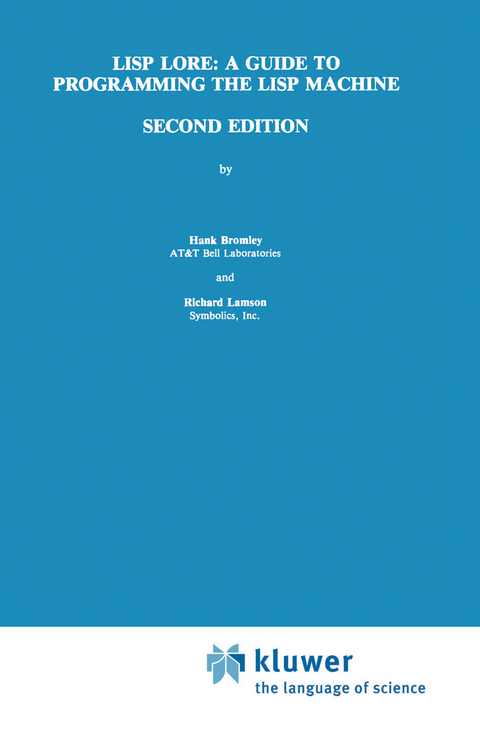
LISP Lore: A Guide to Programming the LISP Machine
Springer-Verlag New York Inc.
978-1-4612-9189-3 (ISBN)
1. Introduction.- 2. Getting Started on the Lisp Machine.- 2.1 Why Use a Lisp Machine?.- 2.2 The Keyboard.- 2.3 Typing to a Lisp Listener.- 2.4 Getting Around the Environment.- 2.5 The Mouse.- 2.5.1 The System Menu.- 2.6 The Monitor.- 2.7 The Editor.- 2.8 The Compiler and the Debugger.- 2.9 Getting Started.- 2.10 A Word About Work Style.- 2.11 This and That.- 2.12 Problem Set #1.- 3. Flow of Control.- 3.1 Conditionals.- 3.2 Blocks and Exits.- 3.3 Nonlocal Exits.- 3.4 Iteration.- 3.5 Lexical Scoping.- 3.6 Macros.- 3.7 Unwind-protect.- 3.8 Fun and Games.- 3.9 Problem Set.- 4. More on Navigating the Lisp Machine.- 4.1 The Scheduler and Processes.- 4.2 Windows.- 4.3 Debugging.- 4.4 The Input Editor and Histories.- 4.5 Mouse Sensitivity.- 4.6 Poking Around.- 4.7 Fun and Games.- 4.8 Problem Set.- 5. What’s a Flavor?.- 5.1 Instance Variables.- 5.2 Methods.- 5.3 Making Instances.- 5.4 Initial Values for Instance Variables.- 5.5 Methods for Make-instance.- 5.6 Mixing Flavors.- 5.7 Combined Methods.- 5.8 Whoppers.- 5.9 Internal Interfaces.- 5.10 Vanilla Flavor.- 5.11 The Flavor Examiner Tools.- 5.12 Message Passing.- 5.13 The Window System.- 5.14 Fun and Games.- 5.15 Problem Set.- 6. User Interface.- 6.1 Program Frameworks: an Overview.- 6.2 Defining Commands.- 6.3 The Redisplay.- 6.4 Presentation Types.- 6.5 Mouse Sensitivity.- 6.6 Fun and Games.- 7. The Graph Example.- 7.1 The Nodes and Arcs.- 7.2 The Presentation Types.- 7.3 The Display.- 7.4 The Commands.- 7.5 The Mouse Gesture Translators.- 7.6 The Program.- 7.7 Problem Set.- 8. Streams and Files.- 8.1 Streams.- 8.2 Accessing Files and Directories.- 8.3 Pathnames.- 8.4 Making Other I/O Streams.- 8.5 Fun and Games.- 8.6 Problem Set.- 9. The Calculator Example.- 9.1 The Program Frame.- 9.2 The Redisplay.- 9.3 TheCommand-definition Macrology.- 9.4 The Program.- 9.5 Fun and Games.- 10. Systems, Storage and Errors.- 10.1 Systems.- 10.2 Storage Allocation.- 10.3 Condition Handling.- 10.4 Fun and Games.- 11. The Card Game Example.- 11.1 Card Definitions.- 11.2 Presentation Types.- 11.3 Card Places.- 11.4 The Interactive Program.- 11.5 The Program.- 11.6 Problem Set.- 11.7 Fun and Games.- 12. More Advanced Use of the Editor.- 12.1 Keyboard Macros.- 12.2 Writing New Commands.- 12.3 Learning More About the Editor.- 12.4 Fun and Games.- 12.5 Problem Set.- 13. A Quick Look At the Network.- 13.1 The Gee-whiz Look.- 13.2 The Generic Network System.- 13.3 The Namespace System.- 13.4 Examples of the Use of the Generic Network System.- 13.5 Writing Your Own Network Software.- APPENDIX A. Basic Zmacs Commands.
| Erscheint lt. Verlag | 23.11.2011 |
|---|---|
| Zusatzinfo | XXIV, 338 p. |
| Verlagsort | New York, NY |
| Sprache | englisch |
| Maße | 155 x 235 mm |
| Themenwelt | Sachbuch/Ratgeber ► Natur / Technik ► Garten |
| Mathematik / Informatik ► Informatik ► Programmiersprachen / -werkzeuge | |
| Informatik ► Theorie / Studium ► Compilerbau | |
| Informatik ► Theorie / Studium ► Künstliche Intelligenz / Robotik | |
| Mathematik / Informatik ► Mathematik ► Angewandte Mathematik | |
| ISBN-10 | 1-4612-9189-5 / 1461291895 |
| ISBN-13 | 978-1-4612-9189-3 / 9781461291893 |
| Zustand | Neuware |
| Informationen gemäß Produktsicherheitsverordnung (GPSR) | |
| Haben Sie eine Frage zum Produkt? |
aus dem Bereich


